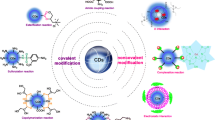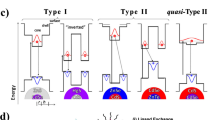Abstract.
It has been shown that diamondoids can interact with DNA by forming relatively strong hydrogen bonds to DNA units, such as nucleobases. For this interaction to occur the diamondoids must be chemically modified in order to provide donor/acceptor groups for the hydrogen bond. We show here that the exact arrangement of an amine-modified adamantane with respect to a neighboring nucleobase has a significant influence on the strength of the hydrogen bond. Whether the diamondoid acts as a hydrogen donor or acceptor in the hydrogen binding to the nucleobase affects the electronic structure and thereby the electronic band-gaps of the diamondoid-nucleobase complex. In a donor arrangement of the diamondoid close to a nucleobase, the interaction energies are weak, but the electronic band-gaps differ significantly. Exactly the opposite trend is observed in an acceptor arrangement of the diamondoid. In each of these cases the frontier orbitals of the diamondoid and the nucleobase play a different role in the binding. The results are discussed in view of a diamondoid-based biosensing device.
Graphical abstract

Similar content being viewed by others
References
J.E. Dahl, S.G. Liu, R.M.K. Carlson, Science 299, 96 (2003)
M.A. Gunawan et al., New. J. Chem. 38, 28 (2014)
H. Schwertfeger, A.A. Fokin, P.R. Schreiner, Angew. Chem. Int. Ed. Engl. 47, 1022 (2008)
W.L. Yang et al., Science 316, 1460 (2007)
Y. Wang, E. Kioupakis, X. Lu, D. Wegner, R. Yamachika, J.E. Dahl, R.M.K. Carlson, S.G. Louie, M.F. Crommie, Nat. Mater. 7, 38 (2008)
G. Zhang, Phys. Today 66, 59 (2013)
G.A. Mansoori, P.L.B. de Araujo, E.S. de Araujo (Editors), Diamondoid Molecules: With Applications in Biomedicine, Materials Science, Nanotechnology & Petroleum Science (World Scientific Pub. Co., 2012)
G.C. McIntosh, M. Yoon, S. Berber, D. Tománek, Phys. Rev. B 70, 045401 (2004)
A.A. Spasov, T.V. Khamidova, L.I. Bugaeva, I. Morozov, Pharm. Chem. J. 34, 1 (2000)
H. Huang, E. Pierstorff, E. Osawa, D. Ho, Nano. Lett. 7, 3305 (2007)
A.L. Stouffer et al., Nature 451, 596 (2008)
L. Wanka, K. Iqbal, P.R. Schreiner, Chem. Rev. 113, 3516 (2013)
J.R. Schnell, J.J. Chou, Nature 451, 591 (2008)
W.J. Geldenhuys, S.F. Malan, J.R. Bloomquist, A.P. Marchand, C.J.V. der Schyf, Med. Res. Rev. 25, 21 (2005)
Y. Xue, G.A. Mansoori, Int. J. Nanosci. 7, 63 (2008)
N.D. Drummond, A.J. Williamson, R.J. Needs, G. Galli, Phys. Rev. Lett. 95, 096801 (2008)
S. Roth et al., Chem. Phys. Lett. 495, 102 (2010)
L. Landt, K. Klünder, J.E. Dahl, R.M.K. Carlson, T. Möller, C. Bostedt, Phys. Rev. Lett. 103, 047702 (2009)
A.A. Fokin et al., Org. Lett. 11, 3068 (2009)
M. Vörös, T. Demjén, T. Scilvási, A. Gali, Phys. Rev. Lett. 108, 267401 (2012)
A.A. Fokin, P.R. Schreiner, Mol. Phys. 107, 823 (2009)
T. Rander et al., J. Chem. Phys. 138, 024310 (2013)
L. Landt et al., J. Chem. Phys. 132, 144305 (2010)
L. Landt et al., J. Chem. Phys. 132, 024710 (2010)
Y. Xue, G.A. Mansoori, Int. J. Mol. Sci. 11, 288 (2010)
Y. Wang, B.A. Tkatchenko, P.R. Schreiner, A. Marx, Org. Biomol. Chem. 9, 7482 (2011)
J.B. Crumpton, W.L. Santos, Chem. Commun. 48, 2018 (2012)
H. Ramezani, M.R. Saberi, G.A. Mansoori, Int. J. Nanosci. Nanotechnol 3, 21 (2007)
G. Sivaraman, M. Fyta, Nanoscale 6, 4225 (2014)
J.M. Soler, E. Artacho, J.D. Gale, A. García, J. Junquera, P. Ordejón, D. Sánchez-Portal, J. Phys.: Condens. Matter 14, 2745 (2002)
K. Lee, E.D. Murray, L. Kong, B.I. Lundqvist, D.C. Langreth, Phys. Rev. B 82, 081101(R) (2010)
J. Klimeš, A. Michaelides, J. Chem. Phys. 137, 120901 (2012)
J. Junquera, O. Paz, D. Sánchez-Portal, E. Artacho, Phys. Rev. B 64, 235111 (2001)
N. Troullier, J.L. Martins, Phys. Rev. B 43, 1993 (1991)
J. Sponer, P. Jurečka, P. Hobza, J. Am. Chem. Soc. 126, 10142 (2004)
S.F. Boys, F. Bernardi, Mol. Phys. 19, 553 (1970)
G.A. Jeffrey, An Introduction to Hydrogen Bonding, in Topics in Physical Chemistry (Oxford University Press, 1997)
Author information
Authors and Affiliations
Corresponding author
Rights and permissions
About this article
Cite this article
C. Maier, F., Sivaraman, G. & Fyta, M. The role of a diamondoid as a hydrogen donor or acceptor in probing DNA nucleobases. Eur. Phys. J. E 37, 95 (2014). https://doi.org/10.1140/epje/i2014-14095-0
Received:
Accepted:
Published:
DOI: https://doi.org/10.1140/epje/i2014-14095-0




